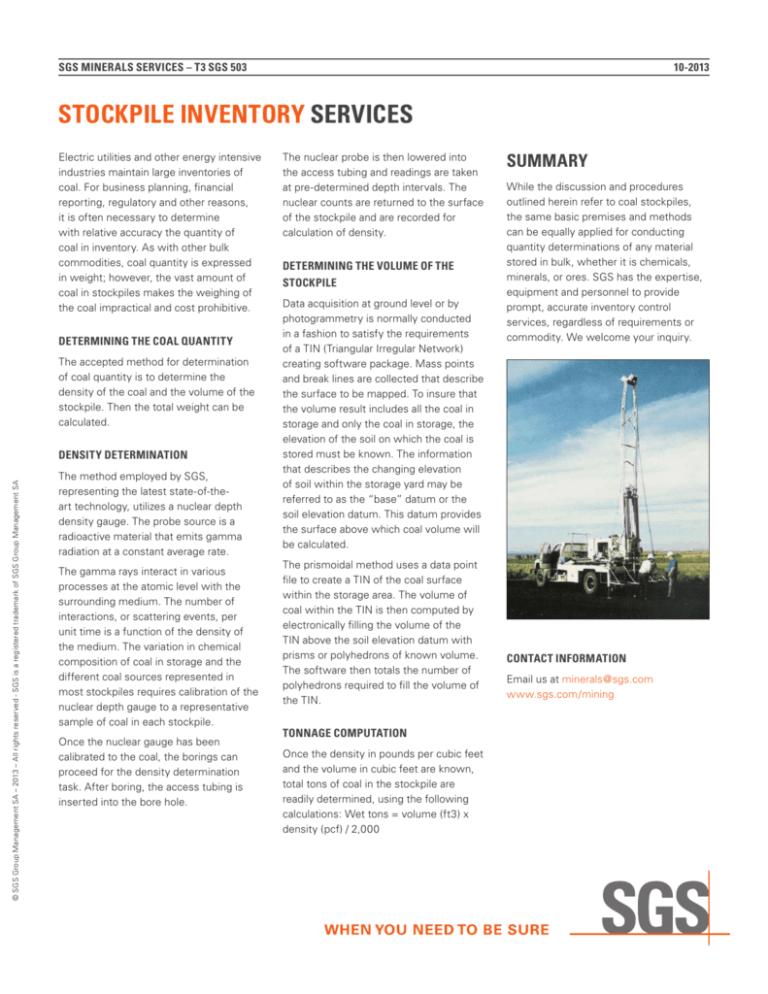
SGS MINERALS SERVICES – T3 SGS 503
10-2013
STOCKPILE INVENTORY SERVICES
Electric utilities and other energy intensive
industries maintain large inventories of
coal. For business planning, financial
reporting, regulatory and other reasons,
it is often necessary to determine
with relative accuracy the quantity of
coal in inventory. As with other bulk
commodities, coal quantity is expressed
in weight; however, the vast amount of
coal in stockpiles makes the weighing of
the coal impractical and cost prohibitive.
DETERMINING THE COAL QUANTITY
The accepted method for determination
of coal quantity is to determine the
density of the coal and the volume of the
stockpile. Then the total weight can be
calculated.
© SGS Group Management SA – 2013 – All rights reserved - SGS is a registered trademark of SGS Group Management SA
DENSITY DETERMINATION
The method employed by SGS,
representing the latest state-of-theart technology, utilizes a nuclear depth
density gauge. The probe source is a
radioactive material that emits gamma
radiation at a constant average rate.
The gamma rays interact in various
processes at the atomic level with the
surrounding medium. The number of
interactions, or scattering events, per
unit time is a function of the density of
the medium. The variation in chemical
composition of coal in storage and the
different coal sources represented in
most stockpiles requires calibration of the
nuclear depth gauge to a representative
sample of coal in each stockpile.
Once the nuclear gauge has been
calibrated to the coal, the borings can
proceed for the density determination
task. After boring, the access tubing is
inserted into the bore hole.
The nuclear probe is then lowered into
the access tubing and readings are taken
at pre-determined depth intervals. The
nuclear counts are returned to the surface
of the stockpile and are recorded for
calculation of density.
DETERMINING THE VOLUME OF THE
STOCKPILE
Data acquisition at ground level or by
photogrammetry is normally conducted
in a fashion to satisfy the requirements
of a TIN (Triangular Irregular Network)
creating software package. Mass points
and break lines are collected that describe
the surface to be mapped. To insure that
the volume result includes all the coal in
storage and only the coal in storage, the
elevation of the soil on which the coal is
stored must be known. The information
that describes the changing elevation
of soil within the storage yard may be
referred to as the “base” datum or the
soil elevation datum. This datum provides
the surface above which coal volume will
be calculated.
The prismoidal method uses a data point
file to create a TIN of the coal surface
within the storage area. The volume of
coal within the TIN is then computed by
electronically filling the volume of the
TIN above the soil elevation datum with
prisms or polyhedrons of known volume.
The software then totals the number of
polyhedrons required to fill the volume of
the TIN.
TONNAGE COMPUTATION
Once the density in pounds per cubic feet
and the volume in cubic feet are known,
total tons of coal in the stockpile are
readily determined, using the following
calculations: Wet tons = volume (ft3) x
density (pcf) / 2,000
SUMMARY
While the discussion and procedures
outlined herein refer to coal stockpiles,
the same basic premises and methods
can be equally applied for conducting
quantity determinations of any material
stored in bulk, whether it is chemicals,
minerals, or ores. SGS has the expertise,
equipment and personnel to provide
prompt, accurate inventory control
services, regardless of requirements or
commodity. We welcome your inquiry.
CONTACT INFORMATION
Email us at minerals@sgs.com
www.sgs.com/mining






